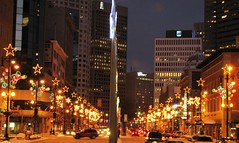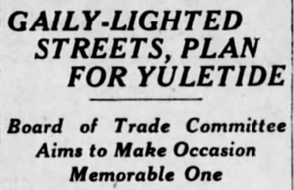Christmas lights today, (source: mrchristian) and 1929, (source: winterbos)
Winnipeg's downtown Christmas lights have already been turned on for 2014. They are an on-again, off-again tradition that is celebrating its 85th anniversary!
Until 1929, downtown Christmas decorations were very much a building-to-building affair. Individual owners and businesses chose whether or not to decorate their display windows or exteriors for the season. The city's efforts consisted of decorations at the city hall square and sometimes a tree at Portage and Main.
The Beautify Winnipeg committee of the Winnipeg Board of Trade, forerunner to the Winnipeg Chamber of Commerce, approached downtown business owners in October 1929 to see if there was interest in a much bigger plan to “inculcate a spirit of cheer and good-will throughout the city.”
Wilbur and Garnet Law
It was the job of Wilbur D. Law, secretary of the Grain Insurance and Guarantee Company and chair of the Board of Trade's Beautify Winnipeg committee, to sell the new plan. Law came to Winnipeg from Minneapolis in his early 20s and spent decades in the grain and insurance industries.
It's likely that his wife, Garnet (Porter) Law, was a good source of advice when it came to putting on a great display. Mrs. Law was a well-known socialite, regularly hosting parties and teas at their Waverley Street home. She also lent her talents to larger, charity fundraising events at hotels and the Manitoba Club.
Top: December 9, 1929, Winnipeg Tribune
Bottom: October 28, 1929, Winnipeg Tribune
The committee wanted Christmas trees attached to lamp posts with cedar boughs strung between them. Cords of electric lights with white, yellow, green and red bulbs would run throughout the greenery. Photos show that it also included strings of lights that stretched across the street.
The initial footprint for these decorations was ambitious. They were to run along Main Street from the CPR station at Higgins Avenue to Union Station at Broadway, and along Portage Avenue from Main Street to Memorial Boulevard. The Main Street plan was scaled back to run only from city hall to Graham Avenue.
Letters were sent to property owners on October 28th, the day before the stock market crash. When the results came back, 85 percent agreed to chip in to the lighting plan. It wasn't the unanimous approval they wanted, but they chose to forge ahead.
With business support behind him, Law's plan was approved by the city.
The Board of Trade had two partners in the program.
One was City Hydro, which gave permission to use their lamp posts and provided a discount on the power that would be used. The Manitoba Electrical Association agreed to cover the cost of the strings of lights and awarded a tender to Schumacher-MacKenzie Company of Winnipeg to do the work.
The Board of Trade and Manitoba Electrical Association also rolled out a secondary campaign with prizes for the best-decorated homes and storefronts around the city. The business winner was Kummen-Shipman Electrical Co. on Fort Street, (above).
The program appears to have been a success. No complaints or mishaps were noted in either newspaper.
It was likely a nice distraction for business owners and visitors who were still reeling from the effects of the crash.
December 4, 1930, Winnipeg Tribune
The downtown decorations would not return in 1930. This was due to drought conditions brought about by the lack of summer rain that caused a power shortage. Winnipeg Hydro announced restrictions on all Christmas lights. They were only allowed from December 24th to January 2nd, from dusk to midnight.
The Board of Trade and Manitoba Electrical Association did, however, repeat its campaign of awarding prizes to the best decorated store windows and homes.
The downtown street decorations returned in 1931, but as the Depression wore on business owners had less money to spend on such things. In 1933, the Board of Trade announced that it was dropping its sponsorship of the program.
The city and City Hydro stepped in to keep the tradition going until sometime during the Second World War.
1956 lights, Western Canadian Pictoral Index D. Longman Collection
It proposed having lit Christmas trees attached to lamp posts and strings of lights across sections of Portage Avenue and Main Street. Along the centre dividers, which had been redesigned since the elimination of streetcars a year earlier, would be a mixture of lit Christmas trees along with painted boards featuring Christmas-themed vignettes.
In October, the city agreed to spend $3,000 on the lights and wiring if the DBA purchased the estimated $1,750 in trees and boards. The Manitoba Power Commission covered the electricity costs.
Mayor George Sharpe flipped the switch to illuminate both the new downtown Christmas lights and the city hall Christmas tree at 4:45 pm on November 30, 1956. It is a tradition that has been carried on for more than half a century.
1974 postcard
The return of the Christmas lights was a great success and in 1959, the Downtown Business Association purchased four illuminated decorations consisting of “spirals, stars and illuminated plastic material” that were installed over Main Street between McDermot & Bannatyne streets.
These strings of lights, affectionately known as “the curlicues”, each contained over 1,000 bulbs, originally in green, white and red. They proved so popular that more were purchased each year until the city had 18 strands of them.
The curlicues did double duty in 1974 when the city was celebrating its centenary. The bulbs were changed to the city’s official colours of blue and gold, and they were left up all year.
The blue and gold curlicues were the defining downtown Christmas decoration for four decades.
Christmas lights on Portage in 2007, (C. Cassidy)
In 1999, new technology and a Portage Avenue redevelopment project meant big changes to the downtown Christmas lights.
Gone were the curlicues and fir boughs in favour of a collection of 750 pole-mounted fixtures depicting snowflakes, angels, elves and poinsettias. There were also five new centre median winter vignettes, which harken back to those from the late 1950s and 1960s.
UPDATE 2025:
There was a big break in the tradition in 2025 when the city replaced its old "heritage style" lamp posts installed on Portage Avenue and Main Street in 1999, with standard posts that do not contain the attachments needed to hold the pole-mounted decorations in place (though the centre meridian vignettes were installed).
According to the city, the new light poles are temporary and in a couple of years, they will again be replaced with ones that can hold the pole-mounted decorations.
There was a big break in the tradition in 2025 when the city replaced its old "heritage style" lamp posts installed on Portage Avenue and Main Street in 1999, with standard posts that do not contain the attachments needed to hold the pole-mounted decorations in place (though the centre meridian vignettes were installed).
According to the city, the new light poles are temporary and in a couple of years, they will again be replaced with ones that can hold the pole-mounted decorations.

























No comments:
Post a Comment